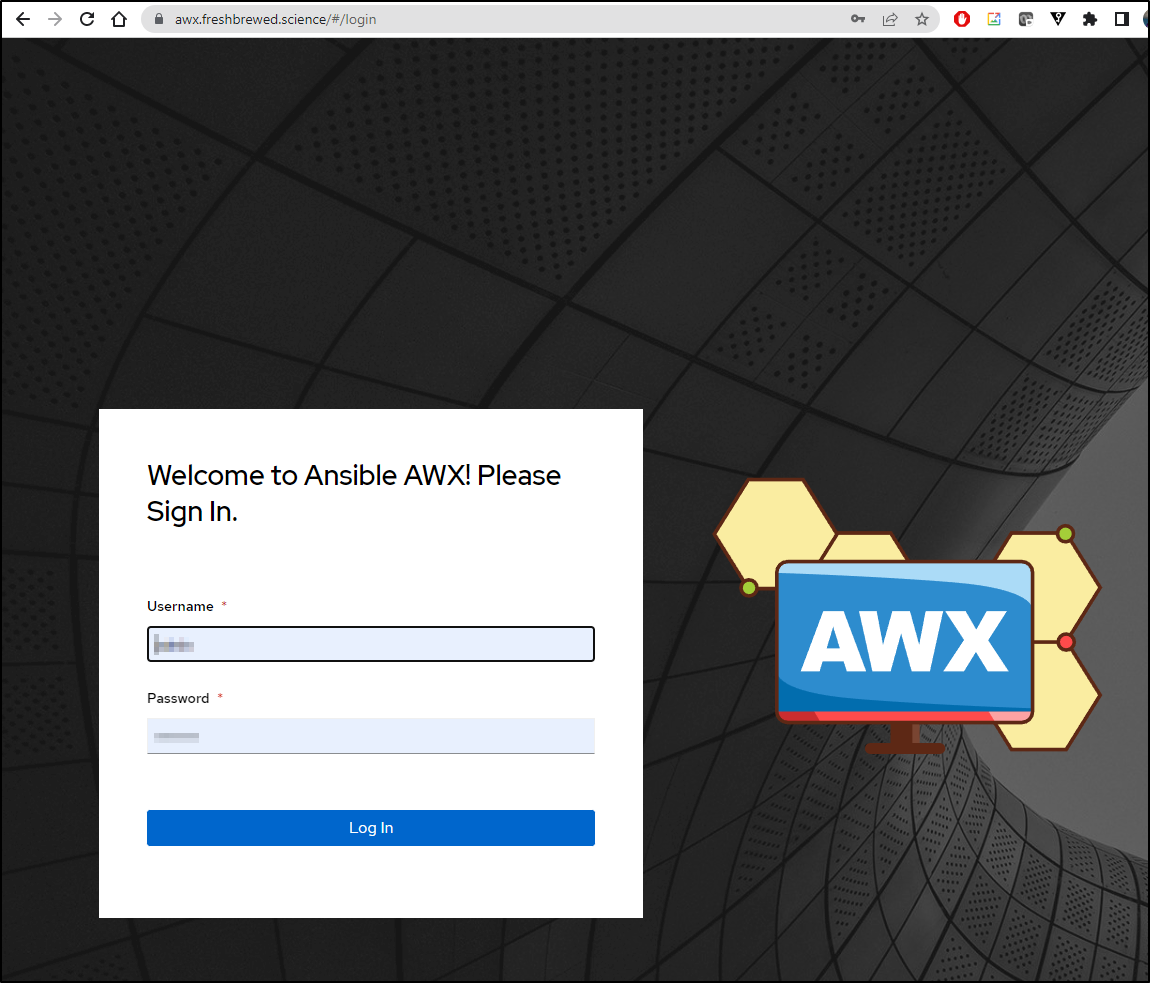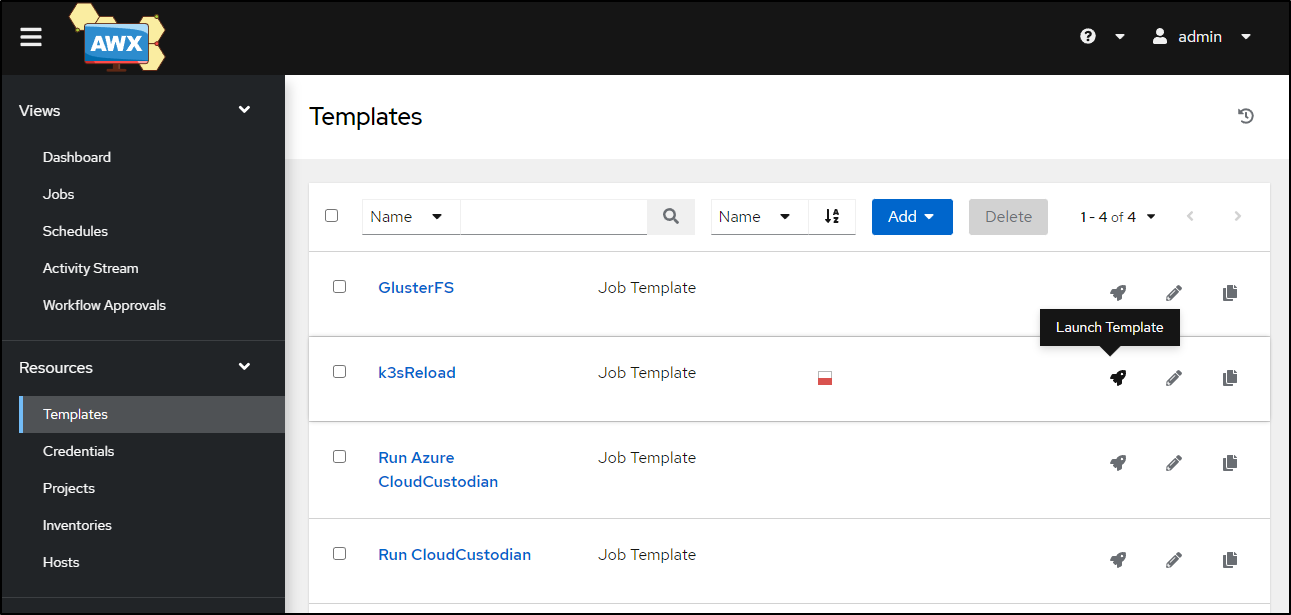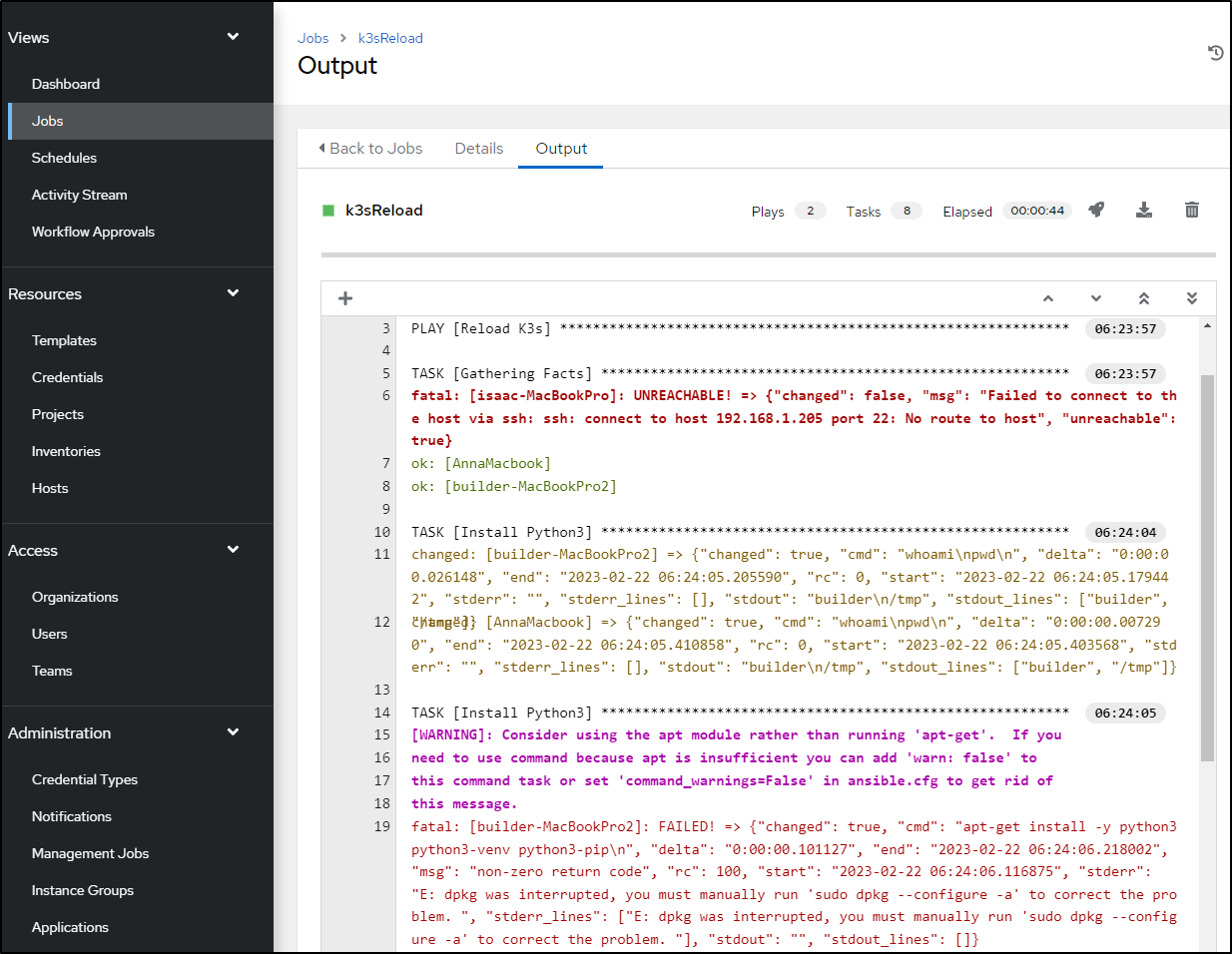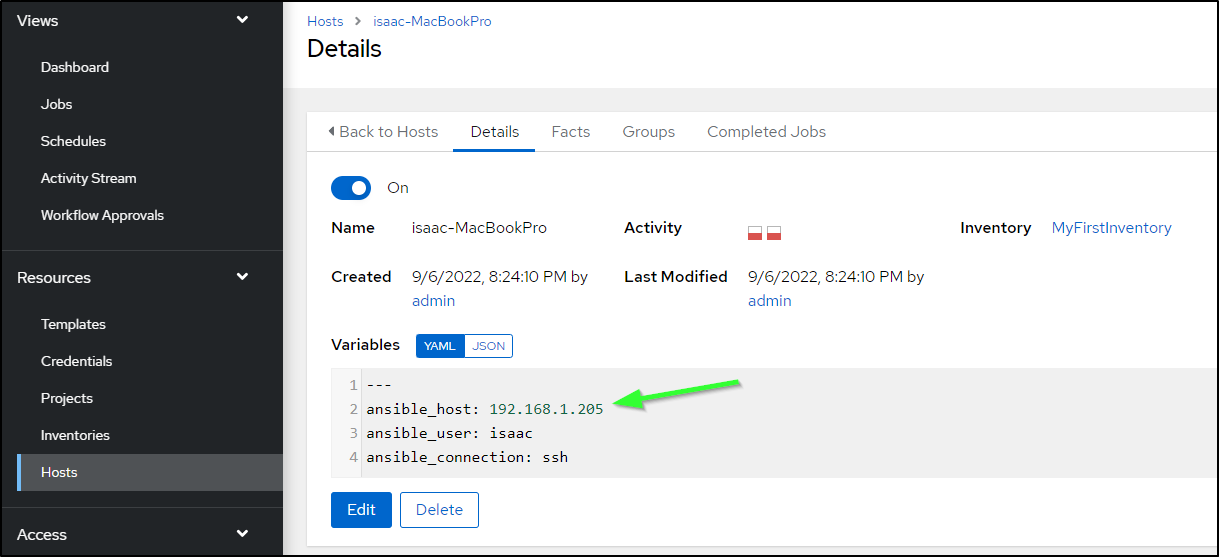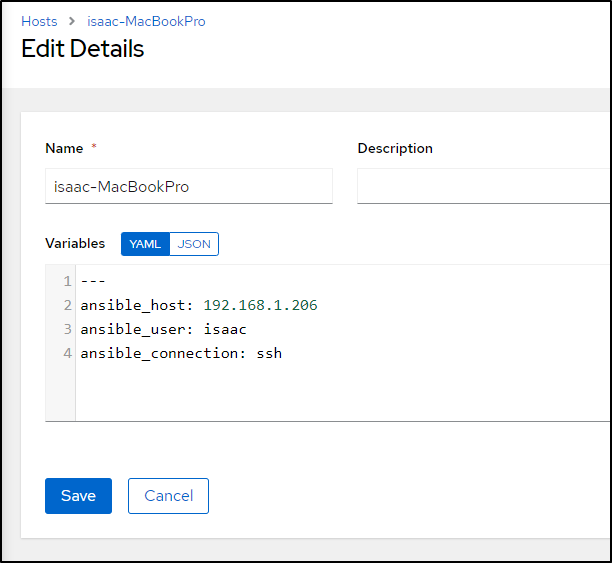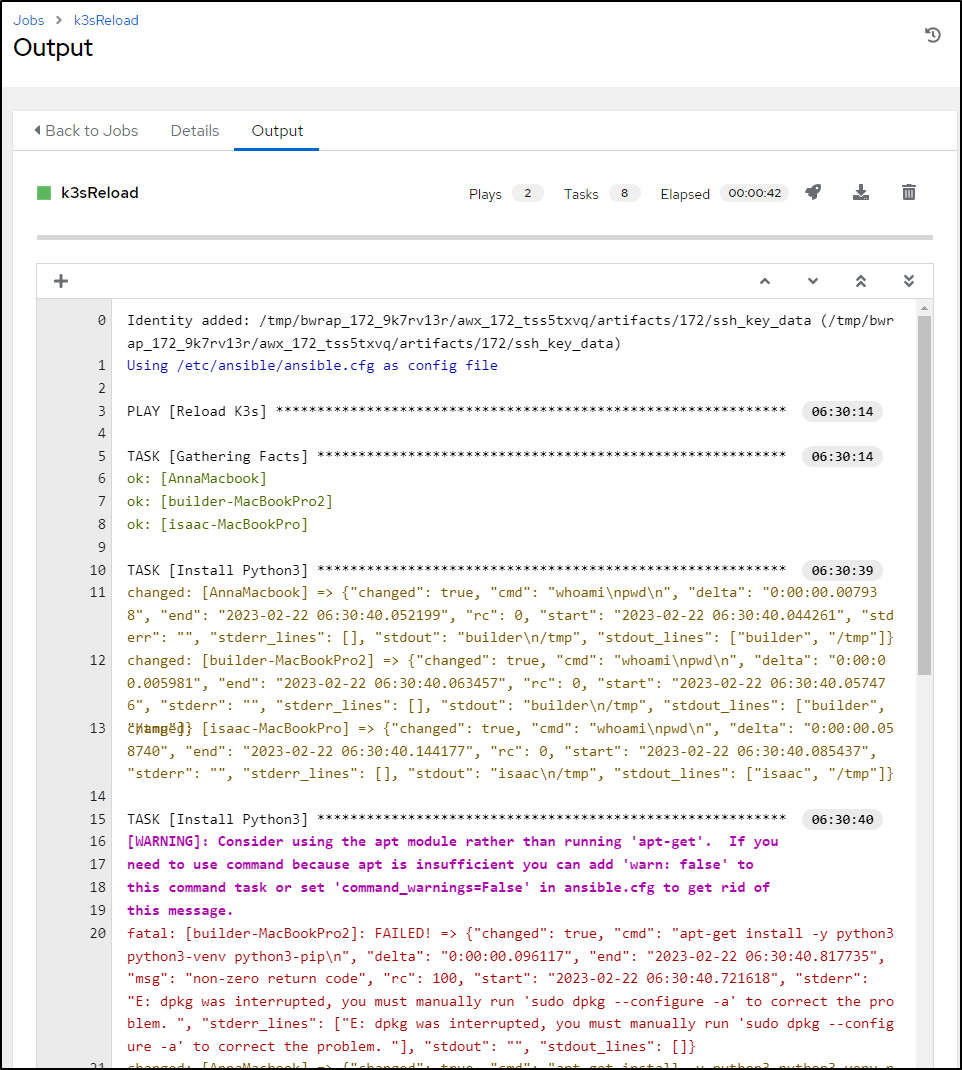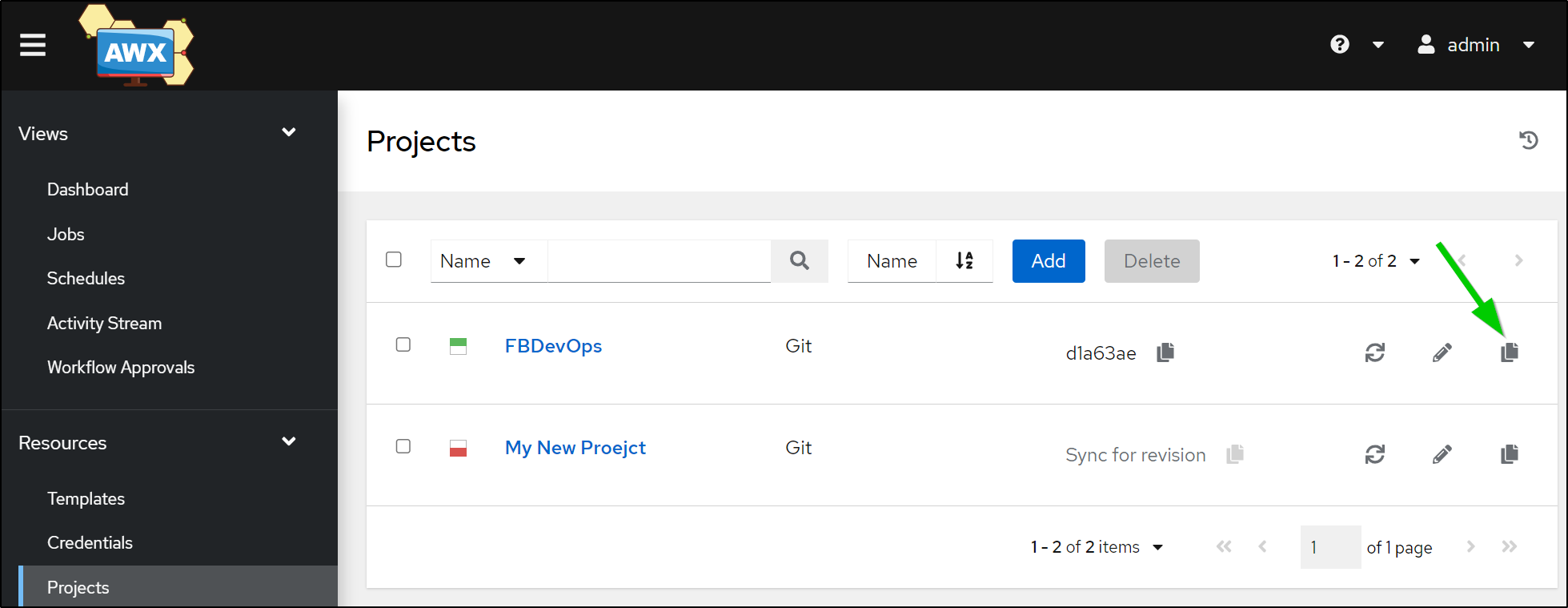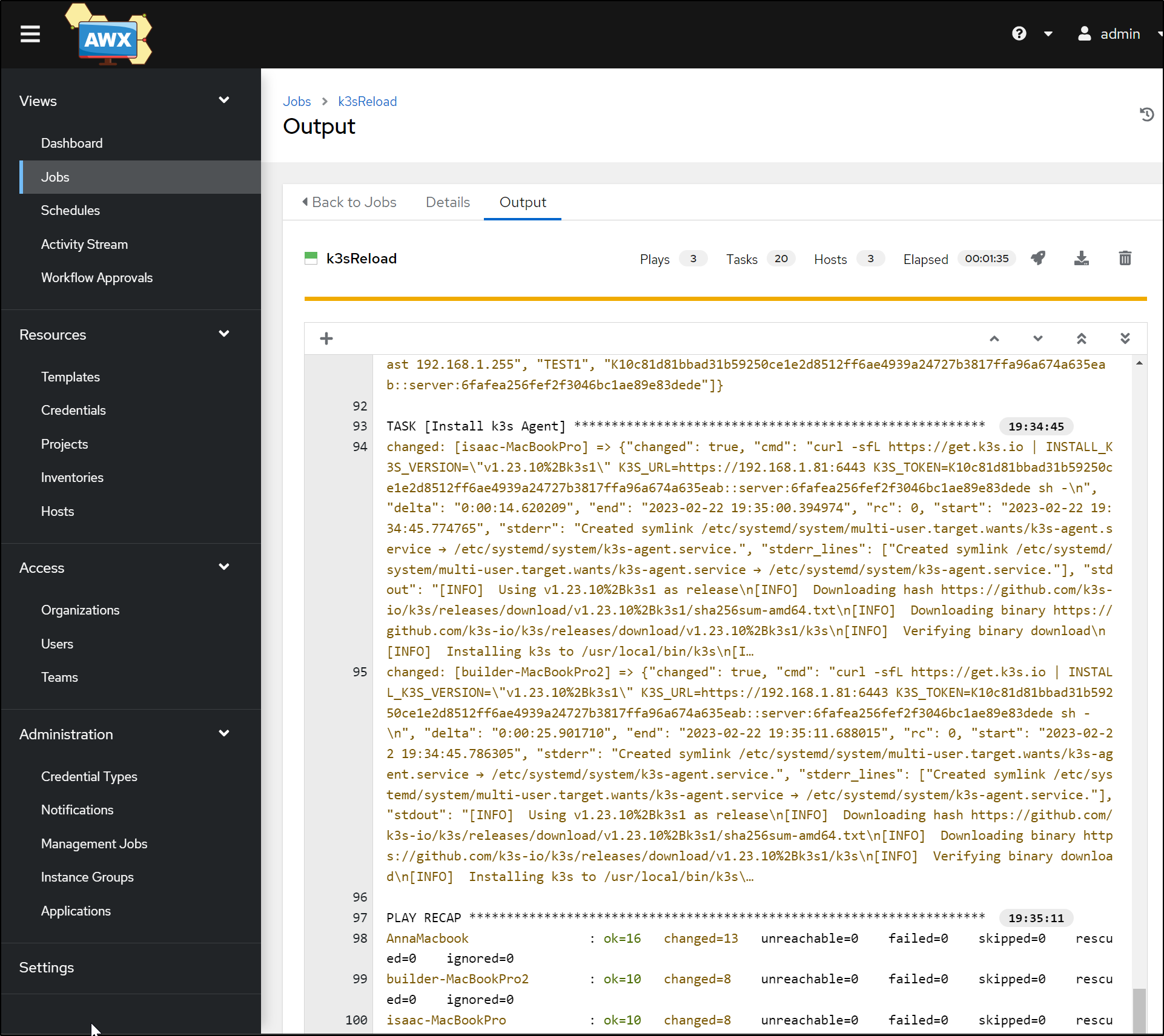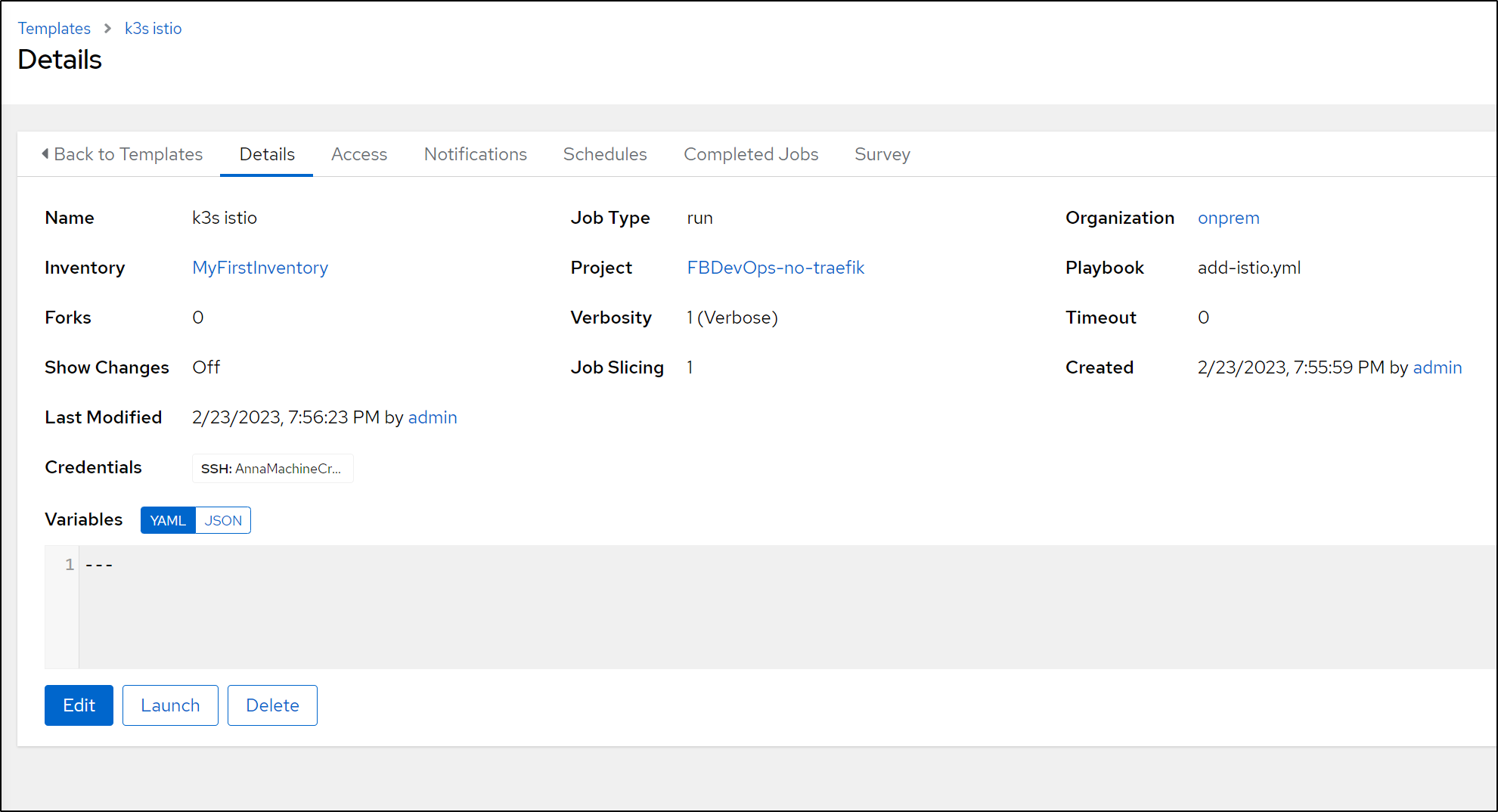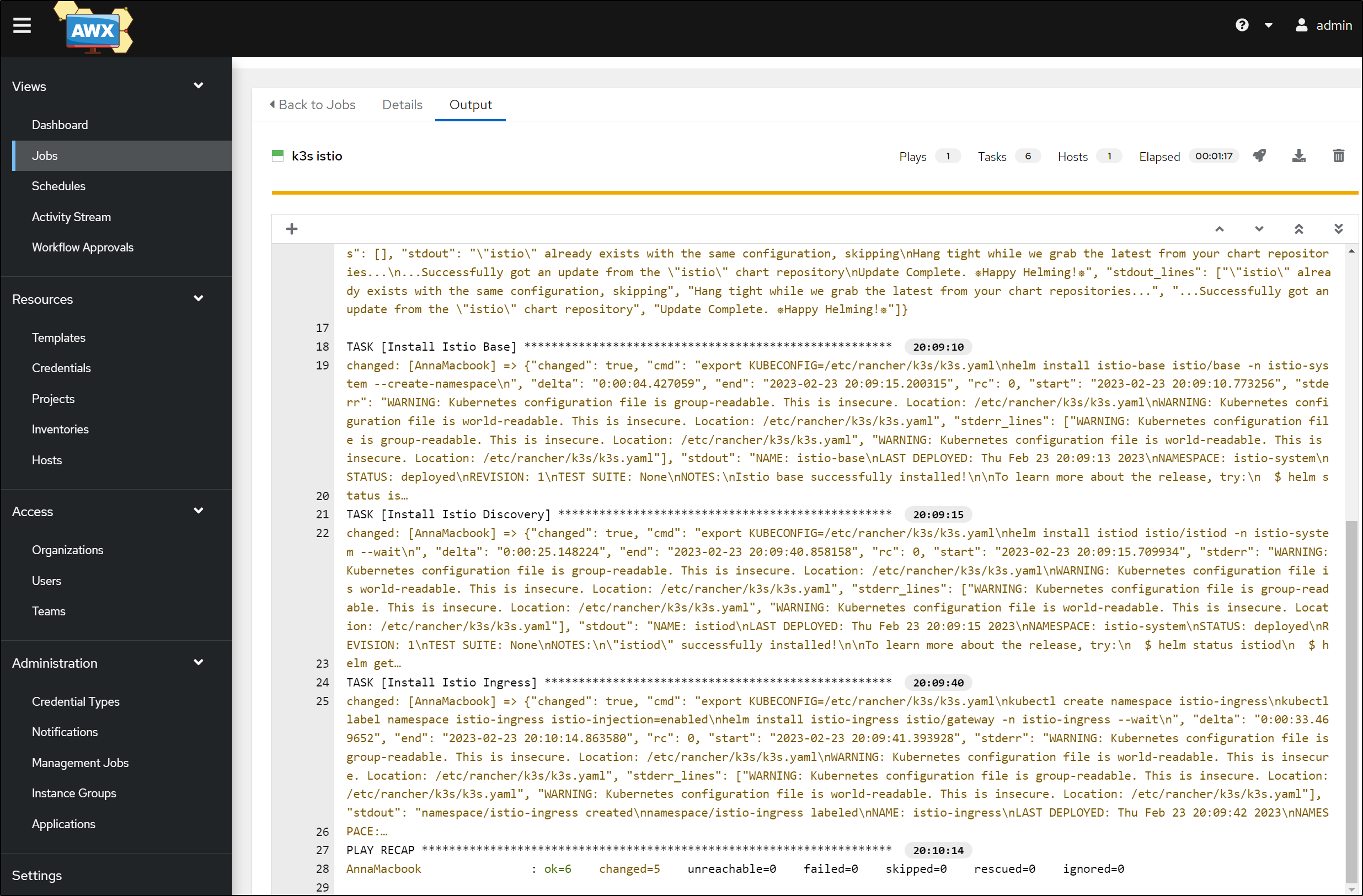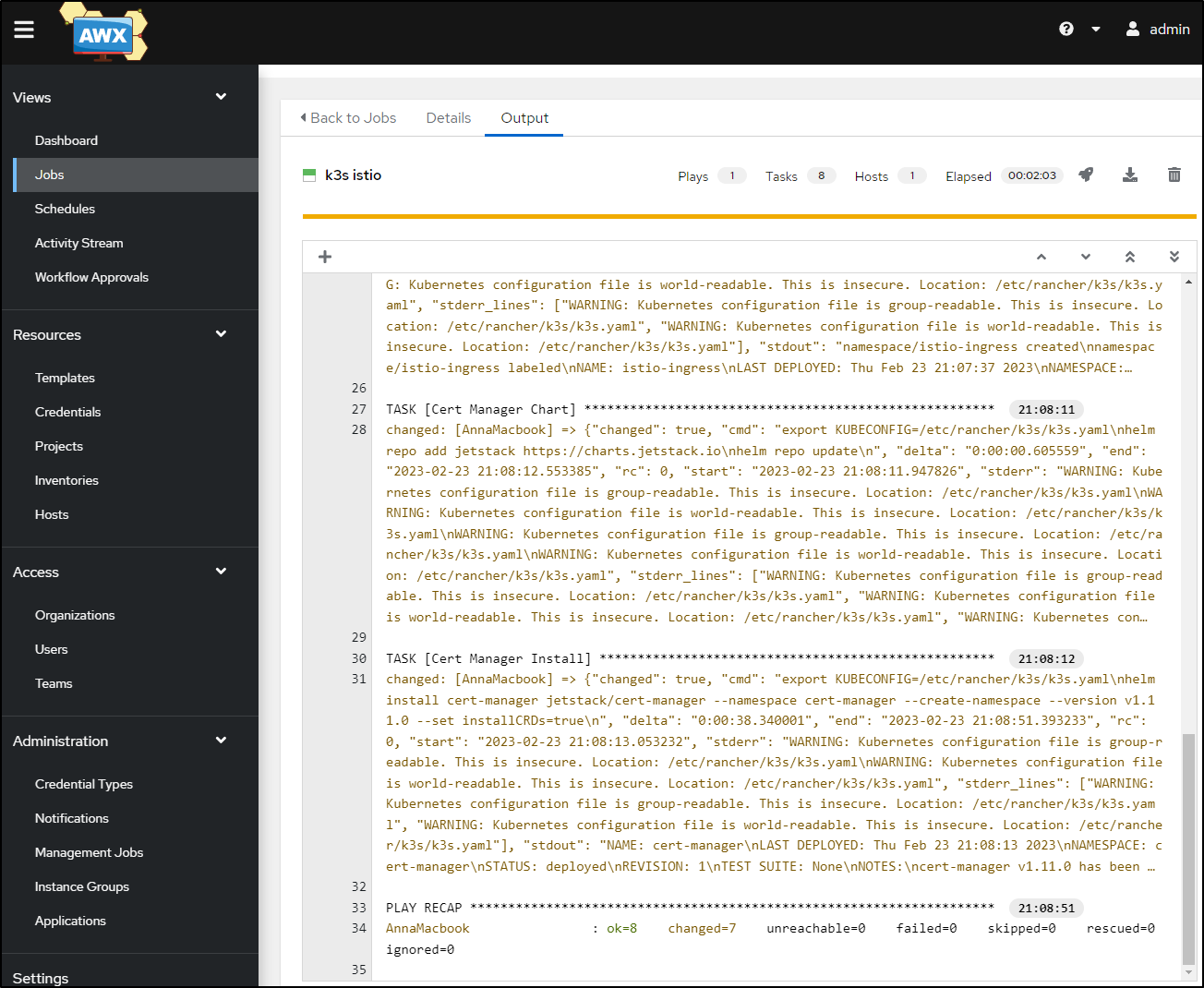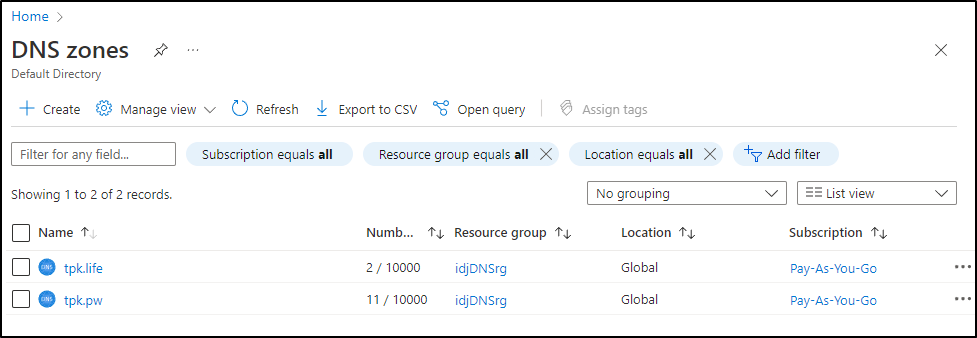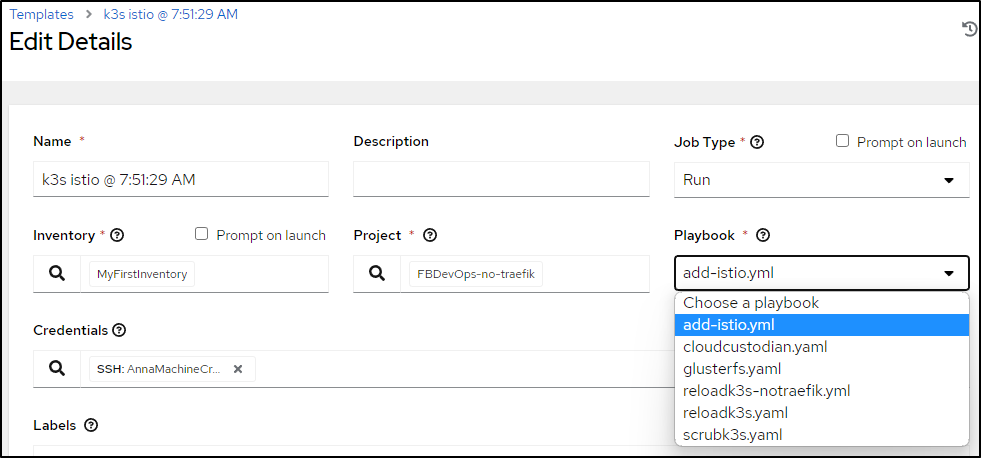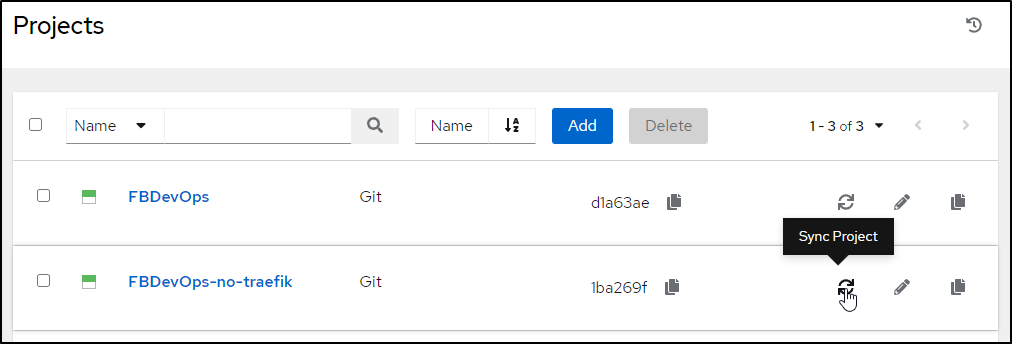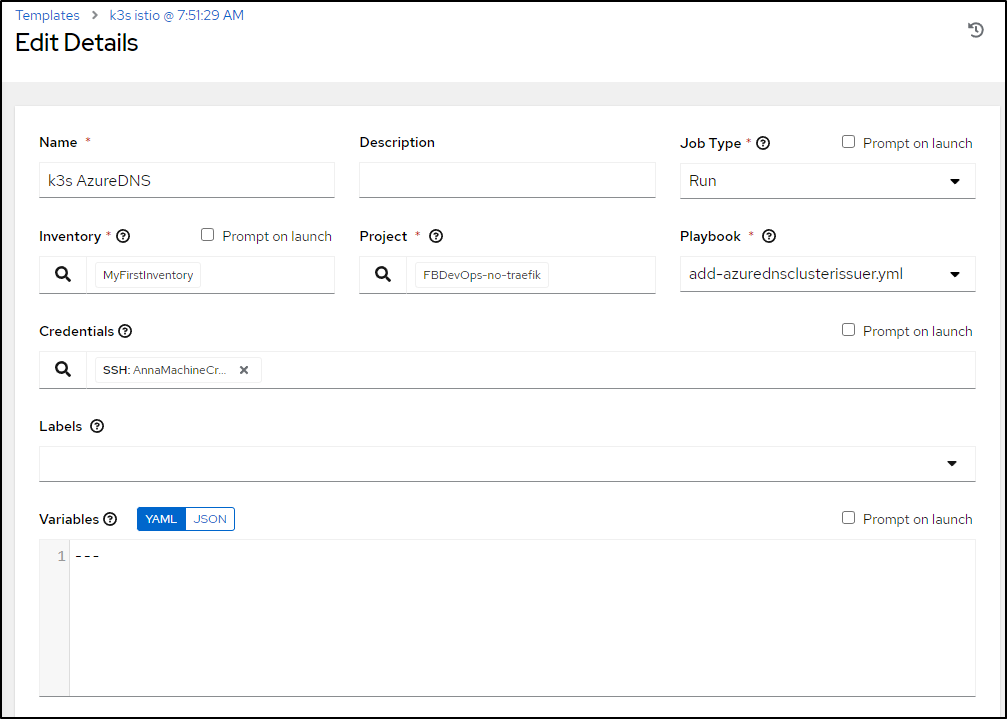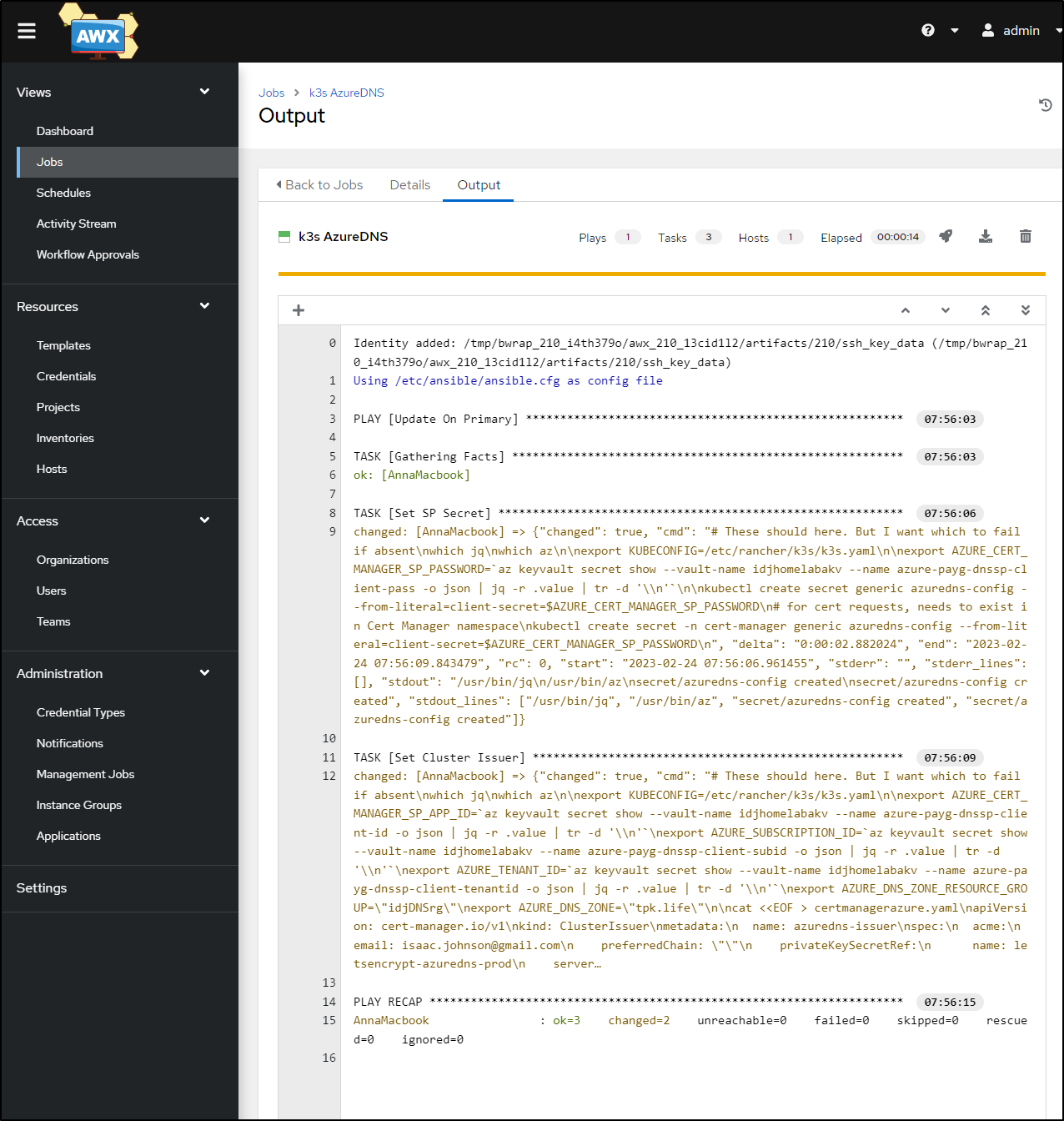Published: Feb 24, 2023 by Isaac Johnson
Today we’ll revisit using Ansible (AWX) to respin and on-prem Kubernetes cluster (K3s). We are not only going to testing creating a K3s cluster without Traefik, but we’ll tackle creating and testing new playbooks that setup Istio and Cert-manager. We’ll then create an Azure SP and tackle Azure DNS with Cert-Manager by making an Azure DNS ClusterIssuer and wrap by building that into a playbook.
Note: All the playbooks referenced below are available in my github repo
Resetting the Secondary On-Prem Cluster with Ansible
Before I can run my playbooks, I really need to ensure az is logged in for the AKV steps. Since most of my accounts have MFA now, this isn’t really something I can over-automate.
I’ll first get a list of hosts
$ kubectl get nodes -o yaml | grep "\- address:"
- address: 192.168.1.159
- address: builder-macbookpro2
- address: 192.168.1.81
- address: anna-macbookair
- address: 192.168.1.206
- address: isaac-macbookpro
On the primary node, first I need to login
$ ssh 192.168.1.81
Welcome to Ubuntu 20.04.4 LTS (GNU/Linux 5.15.0-58-generic x86_64)
* Documentation: https://help.ubuntu.com
* Management: https://landscape.canonical.com
* Support: https://ubuntu.com/advantage
58 updates can be applied immediately.
To see these additional updates run: apt list --upgradable
Your Hardware Enablement Stack (HWE) is supported until April 2025.
Last login: Fri Jan 27 07:34:58 2023 from 192.168.1.160
Dealing with a “stuck” AZ CLI
Then I should upgrade the az cli.
builder@anna-MacBookAir:~$ az upgrade
This command is in preview and under development. Reference and support levels: https://aka.ms/CLI_refstatus
Your current Azure CLI version is 2.39.0. Latest version available is 2.45.0.
Please check the release notes first: https://docs.microsoft.com/cli/azure/release-notes-azure-cli
Do you want to continue? (Y/n): Y
Hit:1 http://us.archive.ubuntu.com/ubuntu focal InRelease
Hit:2 http://us.archive.ubuntu.com/ubuntu focal-updates InRelease
Hit:3 http://us.archive.ubuntu.com/ubuntu focal-backports InRelease
Hit:4 http://packages.cloud.google.com/apt gcsfuse-focal InRelease
Get:5 https://packages.microsoft.com/repos/azure-cli focal InRelease [10.4 kB]
Hit:6 http://ppa.launchpad.net/rmescandon/yq/ubuntu focal InRelease
Hit:7 http://security.ubuntu.com/ubuntu focal-security InRelease
Fetched 10.4 kB in 2s (4,649 B/s)
Reading package lists... Done
Reading package lists... Done
Building dependency tree
Reading state information... Done
azure-cli is already the newest version (2.39.0-1~focal).
The following packages were automatically installed and are no longer required:
libfprint-2-tod1 libfwupdplugin1 libllvm10 libllvm11 shim
Use 'sudo apt autoremove' to remove them.
0 upgraded, 0 newly installed, 0 to remove and 59 not upgraded.
CLI upgrade failed or aborted.
I tried the alternate approach, but it too says 2.39.0 is as high as I can go
builder@anna-MacBookAir:~$ curl -sL https://aka.ms/InstallAzureCLIDeb | sudo bash
Hit:1 http://us.archive.ubuntu.com/ubuntu focal InRelease
Hit:2 http://us.archive.ubuntu.com/ubuntu focal-updates InRelease
Hit:3 http://us.archive.ubuntu.com/ubuntu focal-backports InRelease
Hit:4 http://packages.cloud.google.com/apt gcsfuse-focal InRelease
Hit:5 http://security.ubuntu.com/ubuntu focal-security InRelease
Hit:6 http://ppa.launchpad.net/rmescandon/yq/ubuntu focal InRelease
Get:7 https://packages.microsoft.com/repos/azure-cli focal InRelease [10.4 kB]
Fetched 10.4 kB in 1s (7,114 B/s)
Reading package lists... Done
Reading package lists... Done
Building dependency tree
Reading state information... Done
lsb-release is already the newest version (11.1.0ubuntu2).
curl is already the newest version (7.68.0-1ubuntu2.15).
gnupg is already the newest version (2.2.19-3ubuntu2.2).
apt-transport-https is already the newest version (2.0.9).
The following packages were automatically installed and are no longer required:
libfprint-2-tod1 libfwupdplugin1 libllvm10 libllvm11 shim
Use 'sudo apt autoremove' to remove them.
0 upgraded, 0 newly installed, 0 to remove and 59 not upgraded.
Hit:1 http://us.archive.ubuntu.com/ubuntu focal InRelease
Hit:2 http://us.archive.ubuntu.com/ubuntu focal-updates InRelease
Hit:3 http://us.archive.ubuntu.com/ubuntu focal-backports InRelease
Hit:4 http://packages.cloud.google.com/apt gcsfuse-focal InRelease
Hit:5 http://ppa.launchpad.net/rmescandon/yq/ubuntu focal InRelease
Hit:6 http://security.ubuntu.com/ubuntu focal-security InRelease
Get:7 https://packages.microsoft.com/repos/azure-cli focal InRelease [10.4 kB]
Fetched 10.4 kB in 2s (5,951 B/s)
Reading package lists... Done
Reading package lists... Done
Building dependency tree
Reading state information... Done
azure-cli is already the newest version (2.39.0-1~focal).
The following packages were automatically installed and are no longer required:
libfprint-2-tod1 libfwupdplugin1 libllvm10 libllvm11 shim
Use 'sudo apt autoremove' to remove them.
0 upgraded, 0 newly installed, 0 to remove and 59 not upgraded.
I was reading the notes on the Azure CLI docs where it mentioned an older bundled azure-cli that is part of ubuntu universe.
Once I fully removed azure-cli
builder@anna-MacBookAir:~$ sudo rm /etc/apt/sources.list.d/azure-cli.list
builder@anna-MacBookAir:~$ sudo rm /etc/apt/keyrings/microsoft.gpg
Then the install added the correct current latest.
builder@anna-MacBookAir:~$ curl -sL https://aka.ms/InstallAzureCLIDeb | sudo bash
Hit:1 http://us.archive.ubuntu.com/ubuntu focal InRelease
Hit:2 http://us.archive.ubuntu.com/ubuntu focal-updates InRelease
Hit:3 http://us.archive.ubuntu.com/ubuntu focal-backports InRelease
Hit:4 http://packages.cloud.google.com/apt gcsfuse-focal InRelease
Hit:5 http://security.ubuntu.com/ubuntu focal-security InRelease
Hit:6 http://ppa.launchpad.net/rmescandon/yq/ubuntu focal InRelease
Reading package lists... Done
Reading package lists... Done
Building dependency tree
Reading state information... Done
lsb-release is already the newest version (11.1.0ubuntu2).
curl is already the newest version (7.68.0-1ubuntu2.15).
gnupg is already the newest version (2.2.19-3ubuntu2.2).
apt-transport-https is already the newest version (2.0.9).
The following packages were automatically installed and are no longer required:
libfprint-2-tod1 libfwupdplugin1 libllvm10 libllvm11 shim
Use 'sudo apt autoremove' to remove them.
0 upgraded, 0 newly installed, 0 to remove and 59 not upgraded.
Hit:1 http://us.archive.ubuntu.com/ubuntu focal InRelease
Hit:2 http://security.ubuntu.com/ubuntu focal-security InRelease
Hit:3 http://us.archive.ubuntu.com/ubuntu focal-updates InRelease
Hit:4 http://packages.cloud.google.com/apt gcsfuse-focal InRelease
Hit:5 http://us.archive.ubuntu.com/ubuntu focal-backports InRelease
Hit:6 http://ppa.launchpad.net/rmescandon/yq/ubuntu focal InRelease
Get:7 https://packages.microsoft.com/repos/azure-cli focal InRelease [10.4 kB]
Get:8 https://packages.microsoft.com/repos/azure-cli focal/main amd64 Packages [10.5 kB]
Fetched 20.9 kB in 2s (10.9 kB/s)
Reading package lists... Done
Reading package lists... Done
Building dependency tree
Reading state information... Done
The following packages were automatically installed and are no longer required:
libfprint-2-tod1 libfwupdplugin1 libllvm10 libllvm11 shim
Use 'sudo apt autoremove' to remove them.
The following NEW packages will be installed:
azure-cli
0 upgraded, 1 newly installed, 0 to remove and 59 not upgraded.
Need to get 84.7 MB of archives.
After this operation, 1,250 MB of additional disk space will be used.
Get:1 https://packages.microsoft.com/repos/azure-cli focal/main amd64 azure-cli all 2.45.0-1~focal [84.7 MB]
Fetched 84.7 MB in 5s (15.9 MB/s)
Selecting previously unselected package azure-cli.
(Reading database ... 317327 files and directories currently installed.)
Preparing to unpack .../azure-cli_2.45.0-1~focal_all.deb ...
Unpacking azure-cli (2.45.0-1~focal) ...
Setting up azure-cli (2.45.0-1~focal) ...
Installing new version of config file /etc/bash_completion.d/azure-cli ...
Then I can az login
builder@anna-MacBookAir:~$ az login --use-device-code
To sign in, use a web browser to open the page https://microsoft.com/devicelogin and enter the code A886TCJXQ to authenticate.
The following tenants don't contain accessible subscriptions. Use 'az login --allow-no-subscriptions' to have tenant level access.
2f5b31ae-asdf-asdf-asdf-asdfasdfa741 'mytestdomain'
5b42c447-asdf-asdf-asdf-asdfasdfaec6 'IDJCompleteNonsense'
92a2e5a9-asdf-asdf-asdf-asdfasdfa6d5 'Princess King'
[
{
"cloudName": "AzureCloud",
"homeTenantId": "28c575f6-asdf-asdf-asdf-asdfasdfab4a",
"id": "d955c0ba-asdf-asdf-asdf-asdfasdfa22d",
"isDefault": true,
"managedByTenants": [],
"name": "Pay-As-You-Go",
"state": "Enabled",
"tenantId": "28c575f6-asdf-asdf-asdf-asdfasdfab4a",
"user": {
"name": "isaac.johnson@gmail.com",
"type": "user"
}
}
]
I’ll do a quick Sanity check to ensure the AKV is reachable
builder@anna-MacBookAir:~$ az keyvault secret show --vault-name idjakv --name k3sremoteconfig | jq -r .name
k3sremoteconfig
Resetting with AWX
I’ve pointed out my reset playbook before, but now is a good time to use it.
I’ll log into my AWX
and invoke the Reload Template
This should wipe and reset my secondary k3s cluster. Looking at the logs
We see one issue, the ‘isaac-MacBookPro’ host is unreachable at 192.168.1.205. If you recall our quick ‘kubectl get nodes` command above, you’ll recall that it did change IPs to 192.168.1.206.
This is a quick fix. I just need to go to Hosts and find the fixed IP
Then edit and save it
The job has completed already and I know that my creds have updated since my primary box can no longer use the cert to reach the mac81 cluster
builder@DESKTOP-QADGF36:~$ kubectx mac81
Switched to context "mac81".
builder@DESKTOP-QADGF36:~$ kubectl get nodes
Unable to connect to the server: x509: certificate signed by unknown authority
I like the idempotence of the playbook. I’ll just run it again.
Correcting dpkg errors on nodes
This looks much better, though there seems to be a bit of a dpkg issue on that MacBookPro2 host
I hopped in directly to see what the deal was
builder@builder-MacBookPro2:~$ sudo apt-get install -y python3 python3-venv python3-pip
E: dpkg was interrupted, you must manually run 'sudo dpkg --configure -a' to correct the problem.
I did run the dpkg command which found more and more troubles. A shorthand of what it took to get back to good:
$ sudo apt clean
$ sudo apt update
$ sudo apt -y --fix-broken install
$ sudo apt -y install linux-headers-5.15.0-58-generic
Then the broken step from the playbook worked
builder@builder-MacBookPro2:~$ sudo apt-get install -y python3 python3-venv python3-pip
Reading package lists... Done
Building dependency tree
Reading state information... Done
python3 is already the newest version (3.8.2-0ubuntu2).
python3-venv is already the newest version (3.8.2-0ubuntu2).
The following packages were automatically installed and are no longer required:
libfprint-2-tod1 libllvm10 linux-headers-5.15.0-46-generic linux-hwe-5.15-headers-5.15.0-46
linux-image-5.15.0-46-generic linux-image-5.15.0-57-generic linux-modules-5.15.0-46-generic
linux-modules-5.15.0-57-generic linux-modules-extra-5.15.0-46-generic
linux-modules-extra-5.15.0-57-generic
Use 'sudo apt autoremove' to remove them.
The following additional packages will be installed:
python-pip-whl
The following packages will be upgraded:
python-pip-whl python3-pip
2 upgraded, 0 newly installed, 0 to remove and 121 not upgraded.
Need to get 2,036 kB of archives.
After this operation, 0 B of additional disk space will be used.
Get:1 http://us.archive.ubuntu.com/ubuntu focal-updates/universe amd64 python3-pip all 20.0.2-5ubuntu1.7 [230 kB]
Get:2 http://us.archive.ubuntu.com/ubuntu focal-updates/universe amd64 python-pip-whl all 20.0.2-5ubuntu1.7 [1,805 kB]
Fetched 2,036 kB in 1s (3,284 kB/s)
(Reading database ... 357974 files and directories currently installed.)
Preparing to unpack .../python3-pip_20.0.2-5ubuntu1.7_all.deb ...
Unpacking python3-pip (20.0.2-5ubuntu1.7) over (20.0.2-5ubuntu1.6) ...
Preparing to unpack .../python-pip-whl_20.0.2-5ubuntu1.7_all.deb ...
Unpacking python-pip-whl (20.0.2-5ubuntu1.7) over (20.0.2-5ubuntu1.6) ...
Setting up python-pip-whl (20.0.2-5ubuntu1.7) ...
Setting up python3-pip (20.0.2-5ubuntu1.7) ...
Processing triggers for man-db (2.9.1-1) ...
I had to kick the other host in the pants as well - same issue on ‘isaac-MacBookPro’.
Once all the issues were resolved, the playbook completed successfully
Testing
To use the cluster now, I’ll need to pull a fresh config
builder@DESKTOP-QADGF36:~$ cp ~/.kube/config ~/.kube/config.bak && az keyvault secret show --vault-name idjakv --name k3sremoteconfig | jq -r .value > ~/.kube/config
Then use the context just updated
builder@DESKTOP-QADGF36:~$ kubectx mac81
Switched to context "mac81".
builder@DESKTOP-QADGF36:~$ kubectl get nodes
NAME STATUS ROLES AGE VERSION
builder-macbookpro2 Ready <none> 4m51s v1.23.10+k3s1
isaac-macbookpro Ready <none> 4m59s v1.23.10+k3s1
anna-macbookair Ready control-plane,master 7m34s v1.23.10+k3s1
Istio
Let’s add Istio
builder@DESKTOP-72D2D9T:~$ helm repo add istio https://istio-release.storage.googleapis.com/charts
"istio" has been added to your repositories
builder@DESKTOP-72D2D9T:~$ helm repo update
Hang tight while we grab the latest from your chart repositories...
...Successfully got an update from the "adwerx" chart repository
...Successfully got an update from the "metallb" chart repository
...Successfully got an update from the "cribl" chart repository
...Successfully got an update from the "novum-rgi-helm" chart repository
...Successfully got an update from the "actions-runner-controller" chart repository
...Successfully got an update from the "longhorn" chart repository
...Successfully got an update from the "lifen-charts" chart repository
...Successfully got an update from the "hashicorp" chart repository
...Successfully got an update from the "ingress-nginx" chart repository
...Successfully got an update from the "harbor" chart repository
...Successfully got an update from the "istio" chart repository
...Successfully got an update from the "rook-release" chart repository
...Successfully got an update from the "datadog" chart repository
...Successfully got an update from the "jenkins" chart repository
...Successfully got an update from the "argo-cd" chart repository
...Successfully got an update from the "gitlab" chart repository
...Successfully got an update from the "stable" chart repository
...Successfully got an update from the "bitnami" chart repository
Update Complete. ⎈Happy Helming!⎈
Let’s add the Istio CRD:
builder@DESKTOP-72D2D9T:~$ helm install istio-base istio/base -n istio-system --create-namespace
NAME: istio-base
LAST DEPLOYED: Wed Feb 22 18:39:27 2023
NAMESPACE: istio-system
STATUS: deployed
REVISION: 1
TEST SUITE: None
NOTES:
Istio base successfully installed!
To learn more about the release, try:
$ helm status istio-base
$ helm get all istio-base
Next, we need to install the discovery chart.
builder@DESKTOP-72D2D9T:~$ helm install istiod istio/istiod -n istio-system --wait
NAME: istiod
LAST DEPLOYED: Wed Feb 22 18:43:15 2023
NAMESPACE: istio-system
STATUS: deployed
REVISION: 1
TEST SUITE: None
NOTES:
"istiod" successfully installed!
To learn more about the release, try:
$ helm status istiod
$ helm get all istiod
Next steps:
* Deploy a Gateway: https://istio.io/latest/docs/setup/additional-setup/gateway/
* Try out our tasks to get started on common configurations:
* https://istio.io/latest/docs/tasks/traffic-management
* https://istio.io/latest/docs/tasks/security/
* https://istio.io/latest/docs/tasks/policy-enforcement/
* https://istio.io/latest/docs/tasks/policy-enforcement/
* Review the list of actively supported releases, CVE publications and our hardening guide:
* https://istio.io/latest/docs/releases/supported-releases/
* https://istio.io/latest/news/security/
* https://istio.io/latest/docs/ops/best-practices/security/
For further documentation see https://istio.io website
Tell us how your install/upgrade experience went at https://forms.gle/hMHGiwZHPU7UQRWe9
and get status
$ kubectl get deployments -n istio-system --output wide
NAME READY UP-TO-DATE AVAILABLE AGE CONTAINERS IMAGES SELECTOR
istiod 1/1 1 1 3m58s discovery docker.io/istio/pilot:1.17.0 istio=pilot
Lastly, setup ingress:
builder@DESKTOP-72D2D9T:~$ helm install istio-ingress istio/gateway -n istio-ingress --wait
^CRelease istio-ingress has been cancelled.
Error: INSTALLATION FAILED: context canceled
I’ll save the debug details. The cause is Traefik already exists as my ingress. Thus unless I disable manually or at intsall, the LoadBalancer will be forever stuck
builder@DESKTOP-72D2D9T:~$ kubectl get svc -n istio-ingress
NAME TYPE CLUSTER-IP EXTERNAL-IP PORT(S) AGE
istio-ingress LoadBalancer 10.43.46.25 <pending> 15021:30385/TCP,80:30029/TCP,443:30738/TCP 9m16s
builder@DESKTOP-72D2D9T:~$ kubectl get svc --all-namespaces
NAMESPACE NAME TYPE CLUSTER-IP EXTERNAL-IP PORT(S) AGE
default kubernetes ClusterIP 10.43.0.1 <none> 443/TCP 11h
kube-system kube-dns ClusterIP 10.43.0.10 <none> 53/UDP,53/TCP,9153/TCP 11h
kube-system metrics-server ClusterIP 10.43.118.85 <none> 443/TCP 11h
kube-system traefik LoadBalancer 10.43.212.240 192.168.1.159,192.168.1.206,192.168.1.81 80:30502/TCP,443:30935/TCP 11h
istio-system istiod ClusterIP 10.43.196.48 <none> 15010/TCP,15012/TCP,443/TCP,15014/TCP 16m
istio-ingress istio-ingress LoadBalancer 10.43.46.25 <pending> 15021:30385/TCP,80:30029/TCP,443:30738/TCP 10m
builder@DESKTOP-72D2D9T:~$
I’m going to change this step
- name: Install K3s
ansible.builtin.shell: |
curl -sfL https://get.k3s.io | INSTALL_K3S_VERSION="v1.23.10%2Bk3s1" K3S_KUBECONFIG_MODE="644" INSTALL_K3S_EXEC="--tls-san 73.242.50.46" sh -
become: true
args:
chdir: /tmp
to
- name: Install K3s
ansible.builtin.shell: |
curl -sfL https://get.k3s.io | INSTALL_K3S_VERSION="v1.23.10%2Bk3s1" K3S_KUBECONFIG_MODE="644" INSTALL_K3S_EXEC="--no-deploy traefik --tls-san 73.242.50.46" sh -
become: true
args:
chdir: /tmp
Since I used a new branch, I’ll copy the existing “project”
Then edit the copy
Then I’ll update the branch and name
So now I can change the template to use the new project
and run it
Now that it’s done, I’ll pull down the new Kube config
builder@DESKTOP-72D2D9T:~/Workspaces/jekyll-blog$ kubectx mac81
Switched to context "mac81".
builder@DESKTOP-72D2D9T:~/Workspaces/jekyll-blog$ kubectl get nodes
NAME STATUS ROLES AGE VERSION
anna-macbookair Ready control-plane,master 4m20s v1.23.10+k3s1
builder-macbookpro2 Ready <none> 3m39s v1.23.10+k3s1
isaac-macbookpro Ready <none> 3m50s v1.23.10+k3s1
Now it’s gone
builder@DESKTOP-72D2D9T:~/Workspaces/jekyll-blog$ kubectl get svc --all-namespaces
NAMESPACE NAME TYPE CLUSTER-IP EXTERNAL-IP PORT(S) AGE
default kubernetes ClusterIP 10.43.0.1 <none> 443/TCP 2m16s
kube-system kube-dns ClusterIP 10.43.0.10 <none> 53/UDP,53/TCP,9153/TCP 2m13s
kube-system metrics-server ClusterIP 10.43.12.251 <none> 443/TCP 2m12s
builder@DESKTOP-72D2D9T:~/Workspaces/jekyll-blog$
So now I can try Istio again
$ helm install istio-base istio/base -n istio-system --create-namespace
NAME: istio-base
LAST DEPLOYED: Wed Feb 22 19:57:20 2023
NAMESPACE: istio-system
STATUS: deployed
REVISION: 1
TEST SUITE: None
NOTES:
Istio base successfully installed!
To learn more about the release, try:
$ helm status istio-base
$ helm get all istio-base
Then discovery
$ helm install istiod istio/istiod -n istio-system --wait
NAME: istiod
LAST DEPLOYED: Wed Feb 22 19:58:27 2023
NAMESPACE: istio-system
STATUS: deployed
REVISION: 1
TEST SUITE: None
NOTES:
"istiod" successfully installed!
To learn more about the release, try:
$ helm status istiod
$ helm get all istiod
Next steps:
* Deploy a Gateway: https://istio.io/latest/docs/setup/additional-setup/gateway/
* Try out our tasks to get started on common configurations:
* https://istio.io/latest/docs/tasks/traffic-management
* https://istio.io/latest/docs/tasks/security/
* https://istio.io/latest/docs/tasks/policy-enforcement/
* https://istio.io/latest/docs/tasks/policy-enforcement/
* Review the list of actively supported releases, CVE publications and our hardening guide:
* https://istio.io/latest/docs/releases/supported-releases/
* https://istio.io/latest/news/security/
* https://istio.io/latest/docs/ops/best-practices/security/
For further documentation see https://istio.io website
Tell us how your install/upgrade experience went at https://forms.gle/hMHGiwZHPU7UQRWe9
and lastly ingress
$ kubectl create namespace istio-ingress
namespace/istio-ingress created
$ kubectl label namespace istio-ingress istio-injection=enabled
namespace/istio-ingress labeled
$ helm install istio-ingress istio/gateway -n istio-ingress --wait
NAME: istio-ingress
LAST DEPLOYED: Wed Feb 22 20:01:29 2023
NAMESPACE: istio-ingress
STATUS: deployed
REVISION: 1
TEST SUITE: None
NOTES:
"istio-ingress" successfully installed!
To learn more about the release, try:
$ helm status istio-ingress
$ helm get all istio-ingress
Next steps:
* Deploy an HTTP Gateway: https://istio.io/latest/docs/tasks/traffic-management/ingress/ingress-control/
* Deploy an HTTPS Gateway: https://istio.io/latest/docs/tasks/traffic-management/ingress/secure-ingress/
And that worked
$ kubectl get svc --all-namespaces
NAMESPACE NAME TYPE CLUSTER-IP EXTERNAL-IP PORT(S)
AGE
default kubernetes ClusterIP 10.43.0.1 <none> 443/TCP
18m
kube-system kube-dns ClusterIP 10.43.0.10 <none> 53/UDP,53/TCP,9153/TCP
18m
kube-system metrics-server ClusterIP 10.43.12.251 <none> 443/TCP
18m
istio-system istiod ClusterIP 10.43.36.252 <none> 15010/TCP,15012/TCP,443/TCP,15014/TCP 4m37s
istio-ingress istio-ingress LoadBalancer 10.43.229.35 192.168.1.159,192.168.1.206,192.168.1.81 15021:32219/TCP,80:32336/TCP,443:32298/TCP 97s
Automating Istio
While this worked, I realized I would rather do this with code than have to remember steps each time. So I created the following playbook:
---
- name: Update On Primary
hosts: AnnaMacbook
tasks:
- name: Install Helm
ansible.builtin.shell: |
curl https://baltocdn.com/helm/signing.asc | gpg --dearmor | tee /usr/share/keyrings/helm.gpg > /dev/null
apt-get install apt-transport-https --yes
echo "deb [arch=$(dpkg --print-architecture) signed-by=/usr/share/keyrings/helm.gpg] https://baltocdn.com/helm/stable/debian/ all main" | tee /etc/apt/sources.list.d/helm-stable-debian.list
apt-get update
apt-get install helm
become: true
args:
chdir: /
- name: Add Istio Helm Repo
ansible.builtin.shell: |
helm repo add istio https://istio-release.storage.googleapis.com/charts
helm repo update
become: true
args:
chdir: /tmp
- name: Install Istio Base
ansible.builtin.shell: |
export KUBECONFIG=/etc/rancher/k3s/k3s.yaml
helm install istio-base istio/base -n istio-system --create-namespace
become: true
args:
chdir: /tmp
- name: Install Istio Discovery
ansible.builtin.shell: |
export KUBECONFIG=/etc/rancher/k3s/k3s.yaml
helm install istiod istio/istiod -n istio-system --wait
become: true
args:
chdir: /tmp
- name: Install Istio Ingress
ansible.builtin.shell: |
export KUBECONFIG=/etc/rancher/k3s/k3s.yaml
kubectl create namespace istio-ingress
kubectl label namespace istio-ingress istio-injection=enabled
helm install istio-ingress istio/gateway -n istio-ingress --wait
become: true
args:
chdir: /tmp
Which we can add
Which when run was successful
And I can see it was installed using helm
root@anna-MacBookAir:~# helm list --all-namespaces
WARNING: Kubernetes configuration file is group-readable. This is insecure. Location: /etc/rancher/k3s/k3s.yaml
WARNING: Kubernetes configuration file is world-readable. This is insecure. Location: /etc/rancher/k3s/k3s.yaml
NAME NAMESPACE REVISION UPDATED STATUS CHART APP VERSION
istio-base istio-system 1 2023-02-23 20:09:13.644561258 -0600 CST deployed base-1.17.1 1.17.1
istio-ingress istio-ingress 1 2023-02-23 20:09:42.390759407 -0600 CST deployed gateway-1.17.1 1.17.1
istiod istio-system 1 2023-02-23 20:09:15.992114967 -0600 CST deployed istiod-1.17.1 1.17.1
Then I’ll check locally if I see the service
builder@DESKTOP-72D2D9T:~/Workspaces/jekyll-blog$ cp ~/.kube/config ~/.kube/config.bak && az keyvault secret show --vault-name idjakv --name k3sremoteconfig | jq -r .value > ~/.kube/config
builder@DESKTOP-72D2D9T:~/Workspaces/jekyll-blog$ kubectx mac81
Switched to context "mac81".
builder@DESKTOP-72D2D9T:~/Workspaces/jekyll-blog$ kubectl get svc --all-namespaces
NAMESPACE NAME TYPE CLUSTER-IP EXTERNAL-IP PORT(S) AGE
default kubernetes ClusterIP 10.43.0.1 <none> 443/TCP 35m
kube-system kube-dns ClusterIP 10.43.0.10 <none> 53/UDP,53/TCP,9153/TCP 35m
kube-system metrics-server ClusterIP 10.43.183.100 <none> 443/TCP 35m
istio-system istiod ClusterIP 10.43.246.89 <none> 15010/TCP,15012/TCP,443/TCP,15014/TCP 24m
istio-ingress istio-ingress LoadBalancer 10.43.199.160 192.168.1.159,192.168.1.206,192.168.1.81 15021:30343/TCP,80:32245/TCP,443:30262/TCP 24m
Since that worked so well, I decided to roll on to Cert-Manager
- name: Cert Manager Chart
ansible.builtin.shell: |
export KUBECONFIG=/etc/rancher/k3s/k3s.yaml
helm repo add jetstack https://charts.jetstack.io
helm repo update
become: true
args:
chdir: /tmp
- name: Cert Manager Install
ansible.builtin.shell: |
export KUBECONFIG=/etc/rancher/k3s/k3s.yaml
helm install cert-manager jetstack/cert-manager --namespace cert-manager --create-namespace --version v1.11.0 --set installCRDs=true
become: true
args:
chdir: /tmp
We can see when added to the Istio Ansible playbook, it works just fine
Cert Manager Resolver
I’ve done AWS Route53 ClusterIssuers for years now.
They simply need an AWS IAM user that can affect Route53.
Mine tends to look like this with the IAM Access Key plain text and the Secret Key in a K8s secret:
$ kubectl get clusterissuer letsencrypt-prod -o yaml
apiVersion: cert-manager.io/v1
kind: ClusterIssuer
metadata:
annotations:
kubectl.kubernetes.io/last-applied-configuration: |
{"apiVersion":"cert-manager.io/v1","kind":"ClusterIssuer","metadata":{"annotations":{},"name":"letsencrypt-prod"},"spec":{"acme":{"email":"isaac.johnson@gmail.com","privateKeySecretRef":{"name":"letsencrypt-prod"},"server":"https://acme-v02.api.letsencrypt.org/directory","solvers":[{"dns01":{"route53":{"accessKeyID":"AKIASDFASDFASDFASDFASDF","region":"us-east-1","role":"arn:aws:iam::0123412341234:role/MyACMERole","secretAccessKeySecretRef":{"key":"secret-access-key","name":"prod-route53-credentials-secret"}}},"selector":{"dnsZones":["freshbrewed.science"]}}]}}}
creationTimestamp: "2022-07-26T02:24:57Z"
generation: 1
name: letsencrypt-prod
resourceVersion: "1243"
uid: c1188105-asdf-asdf-asdf-e286905317bc
spec:
acme:
email: isaac.johnson@gmail.com
preferredChain: ""
privateKeySecretRef:
name: letsencrypt-prod
server: https://acme-v02.api.letsencrypt.org/directory
solvers:
- dns01:
route53:
accessKeyID: AKIASDFASDFASDFASDFASDF
region: us-east-1
role: arn:aws:iam::0123412341234:role/MyACMERole
secretAccessKeySecretRef:
key: secret-access-key
name: prod-route53-credentials-secret
selector:
dnsZones:
- freshbrewed.science
status:
acme:
lastRegisteredEmail: isaac.johnson@gmail.com
uri: https://acme-v02.api.letsencrypt.org/acme/acct/646879196
conditions:
- lastTransitionTime: "2022-07-26T02:24:58Z"
message: The ACME account was registered with the ACME server
observedGeneration: 1
reason: ACMEAccountRegistered
status: "True"
type: Ready
But what about Azure or GCP?
Azure DNS in Cert Manager
I have a couple of Hosted Zones already in Azure
Let’s use tpk.life as an example.
I have to dance between a lot of Azure accounts, so before I do anything, I’ll azure login and set my subscription
$ az login
$ az account set --subscription 'Pay-As-You-Go'
I’ll set some basic env vars that we’ll use fo the Zone RG, Name and this new SP Name
builder@DESKTOP-QADGF36:~$ AZURE_CERT_MANAGER_NEW_SP_NAME=paygazurednssa
builder@DESKTOP-QADGF36:~$ AZURE_DNS_ZONE_RESOURCE_GROUP=idjDNSrg
builder@DESKTOP-QADGF36:~$ AZURE_DNS_ZONE=tpk.life
Then I’ll create the SP and capture its JSON creds
builder@DESKTOP-QADGF36:~$ DNS_SP=`az ad sp create-for-rbac --name $AZURE_CERT_MANAGER_NEW_SP_NAME --output json`
WARNING: The output includes credentials that you must protect. Be sure that you do not include these credentials in your code or check the credentials into your source control. For more information, see https://aka.ms/azadsp-cli
Next, I’ll pull some values like the SP ID (App ID), Client Secret and the Tenant from that file. I’ll also get my subscription ID (I passed in the name to keep it clear)
builder@DESKTOP-QADGF36:~$ AZURE_CERT_MANAGER_SP_APP_ID=`echo $DNS_SP | jq -r '.appId'`
builder@DESKTOP-QADGF36:~$ AZURE_CERT_MANAGER_SP_PASSWORD=`echo $DNS_SP | jq -r '.password'`
builder@DESKTOP-QADGF36:~$ AZURE_TENANT_ID=`echo $DNS_SP | jq -r '.tenant'`
builder@DESKTOP-QADGF36:~$ AZURE_SUBSCRIPTION_ID=`az account show --subscription Pay-As-You-Go --output json | jq -r '.id'`
Since we are following the pattern of least-priveledge, let’s remove Contributor (if set), but add in DNS Zone Contributor.
builder@DESKTOP-QADGF36:~$ az role assignment delete --assignee $AZURE_CERT_MANAGER_SP_APP_ID --role Contributor
No matched assignments were found to delete
builder@DESKTOP-QADGF36:~$ DNS_ID=`az network dns zone show --name $AZURE_DNS_ZONE --resource-group $AZURE_DNS_ZONE_RESOURCE_GROUP --query "id" --output tsv`
builder@DESKTOP-QADGF36:~$ az role assignment create --assignee $AZURE_CERT_MANAGER_SP_APP_ID --role "DNS Zone Contributor" --scope $DNS_ID
{
"canDelegate": null,
"condition": null,
"conditionVersion": null,
"description": null,
"id": "/subscriptions/asdfsadfasd-asdf-asdf-asdf-asdfasdfasfasdf/resourceGroups/idjdnsrg/providers/Microsoft.Network/dnszones/tpk.life/providers/Microsoft.Authorization/roleAssignments/asdfasdfasdf-asdf-asdf-asdf-asdfasdfsa",
"name": "asdfasdfasd-asdf-asdf-asdf-asdfasdfas",
"principalId": "asdfasdf-asdf-asfd-asdf-asfadsfas",
"principalType": "ServicePrincipal",
"resourceGroup": "idjdnsrg",
"roleDefinitionId": "/subscriptions/asfdasdf-asdf-asfd-asdf-asfasdfasafas/providers/Microsoft.Authorization/roleDefinitions/asdfasfd-asfd-asdf-asdf-272fasdfasfasdff33ce314",
"scope": "/subscriptions/asfdasfd-asdf-asdf-asfd-asfasdfas/resourceGroups/idjdnsrg/providers/Microsoft.Network/dnszones/tpk.life",
"type": "Microsoft.Authorization/roleAssignments"
}
I can now check which assignments this SP has.
$ az role assignment list --all --assignee $AZURE_CERT_MANAGER_SP_APP_ID | jq '.[] | .roleDefinitionName'
"DNS Zone Contributor"
Using our env vars
I’ll first create a secret in K8s that the ClusterIssuer will use
$ kubectl create secret generic azuredns-config --from-literal=client-secret=$AZURE_CERT_MANAGER_SP_PASSWORD
secret/azuredns-config created
Then I’ll create a YAML file with the values
cat <<EOF > certmanagerazure.yaml
apiVersion: cert-manager.io/v1
kind: ClusterIssuer
metadata:
name: azuredns-issuer
spec:
acme:
email: isaac.johnson@gmail.com
preferredChain: ""
privateKeySecretRef:
name: letsencrypt-azuredns-prod
server: https://acme-v02.api.letsencrypt.org/directory
solvers:
- dns01:
azureDNS:
clientID: $AZURE_CERT_MANAGER_SP_APP_ID
clientSecretSecretRef:
# The following is the secret we created in Kubernetes. Issuer will use this to present challenge to Azure DNS.
name: azuredns-config
key: client-secret
subscriptionID: $AZURE_SUBSCRIPTION_ID
tenantID: $AZURE_TENANT_ID
resourceGroupName: $AZURE_DNS_ZONE_RESOURCE_GROUP
hostedZoneName: $AZURE_DNS_ZONE
# Azure Cloud Environment, default to AzurePublicCloud
environment: AzurePublicCloud
selector:
dnsZones:
- $AZURE_DNS_ZONE
EOF
That should look like
$ cat certmanagerazure.yaml
apiVersion: cert-manager.io/v1
kind: ClusterIssuer
metadata:
name: azuredns-issuer
spec:
acme:
email: isaac.johnson@gmail.com
preferredChain: ""
privateKeySecretRef:
name: letsencrypt-azuredns-prod
server: https://acme-v02.api.letsencrypt.org/directory
solvers:
- dns01:
azureDNS:
clientID: 404f849b-asdf-asdf-asdf-asdfasfsafasdas
clientSecretSecretRef:
# The following is the secret we created in Kubernetes. Issuer will use this to present challenge to Azure DNS.
name: azuredns-config
key: client-secret
subscriptionID: d955c0ba-asdf-asdf-asdf-asdfasfsafasdas
tenantID: 28c575f6-asdf-asdf-asdf-asdfasfsafasdas
resourceGroupName: idjDNSrg
hostedZoneName: tpk.life
# Azure Cloud Environment, default to AzurePublicCloud
environment: AzurePublicCloud
selector:
dnsZones:
- tpk.life
We can now create that ClusterIssuer
$ kubectl apply -f certmanagerazure.yaml
clusterissuer.cert-manager.io/azkubectl get uredns-issuer created
I can now see the secrets; both the one I set with SP Pass and the created Cluster Issuer secret. I can also see my ClusterIssuer is live and ready
builder@DESKTOP-QADGF36:~/Workspaces/ansible-playbooks$ kubectl get secret --all-namespaces | grep azuredns
default azuredns-config Opaque 1 20m
cert-manager letsencrypt-azuredns-prod Opaque 1 15m
builder@DESKTOP-QADGF36:~/Workspaces/ansible-playbooks$ kubectl get clusterissuer
NAME READY AGE
azuredns-issuer True 15m
Let’s test by making a sample cert
$ cat <<EOF >testcert.yml
apiVersion: cert-manager.io/v1
kind: Certificate
metadata:
name: tpk-life-test-cert
namespace: istio-system
spec:
secretName: tpk-life-test-cert
duration: 2160h # 90d
renewBefore: 360h # 15d
isCA: false
privateKey:
algorithm: RSA
encoding: PKCS1
size: 2048
usages:
- server auth
- client auth
dnsNames:
- "testing123.tpk.life"
issuerRef:
name: letsencrypt-azuredns-prod
kind: ClusterIssuer
group: cert-manager.io
EOF
$ kubectl apply -f testcert.yml
certificate.cert-manager.io/tpk-life-test-cert created
$ kubectl get cert -n istio-system
NAME READY SECRET AGE
tpk-life-test-cert False tpk-life-test-cert 52s
$ kubectl get certificaterequest --all-namespaces
NAMESPACE NAME APPROVED DENIED READY ISSUER REQUESTOR AGE
istio-system tpk-life-test-cert-4w866 True False letsencrypt-azuredns-prod system:serviceaccount:cert-manager:cert-manager 76s
I see that my clusterissuer being in ‘default’ namespace is causing some issues
builder@DESKTOP-QADGF36:~/Workspaces/ansible-playbooks$ kubectl describe certificaterequest tpk-life-test-cert-4w866 -n istio-system | tail -n5
Normal IssuerNotFound 2m30s cert-manager-certificaterequests-issuer-ca Referenced "ClusterIssuer" not found: clusterissuer.cert-manager.io "letsencrypt-azuredns-prod" not found
Normal IssuerNotFound 2m30s cert-manager-certificaterequests-issuer-selfsigned Referenced "ClusterIssuer" not found: clusterissuer.cert-manager.io "letsencrypt-azuredns-prod" not found
Normal IssuerNotFound 2m30s cert-manager-certificaterequests-issuer-vault Referenced "ClusterIssuer" not found: clusterissuer.cert-manager.io "letsencrypt-azuredns-prod" not found
Normal IssuerNotFound 2m30s cert-manager-certificaterequests-issuer-venafi Referenced "ClusterIssuer" not found: clusterissuer.cert-manager.io "letsencrypt-azuredns-prod" not found
Normal IssuerNotFound 2m30s cert-manager-certificaterequests-issuer-acme Referenced "ClusterIssuer" not found: clusterissuer.cert-manager.io "letsencrypt-azuredns-prod" not found
I’ll delete and try again, but in default (and changing the Issuer from letsencrypt-azuredns-prod to azuredns-issuer)
$ kubectl delete -f testcert.yml
certificate.cert-manager.io "tpk-life-test-cert" deleted
$ vi testcert.yml
$ cat testcert.yml
apiVersion: cert-manager.io/v1
kind: Certificate
metadata:
name: tpk-life-test3-cert
spec:
secretName: tpk-life-test3-cert
duration: 2160h # 90d
renewBefore: 360h # 15d
isCA: false
privateKey:
algorithm: RSA
encoding: PKCS1
size: 2048
usages:
- server auth
- client auth
dnsNames:
- "testing1234.tpk.life"
issuerRef:
name: azuredns-issuer
kind: ClusterIssuer
group: cert-manager.io
$ kubectl apply -f testcert.yml
certificate.cert-manager.io/tpk-life-test2-cert created
I can check the status
$ kubectl get certificaterequest --all-namespaces
NAMESPACE NAME APPROVED DENIED READY ISSUER REQUESTOR AGE
default tpk-life-test3-cert-fn85s True False azuredns-issuer system:serviceaccount:cert-manager:cert-manager 42s
This time it looks like we are moving along just fine
$ kubectl describe certificaterequest tpk-life-test3-cert-fn85s | tail -n10
Type Reason Age From Message
---- ------ ---- ---- -------
Normal WaitingForApproval 63s cert-manager-certificaterequests-issuer-acme Not signing CertificateRequest until it is Approved
Normal WaitingForApproval 63s cert-manager-certificaterequests-issuer-vault Not signing CertificateRequest until it is Approved
Normal WaitingForApproval 63s cert-manager-certificaterequests-issuer-venafi Not signing CertificateRequest until it is Approved
Normal WaitingForApproval 63s cert-manager-certificaterequests-issuer-selfsigned Not signing CertificateRequest until it is Approved
Normal WaitingForApproval 63s cert-manager-certificaterequests-issuer-ca Not signing CertificateRequest until it is Approved
Normal cert-manager.io 63s cert-manager-certificaterequests-approver Certificate request has been approved by cert-manager.io
Normal OrderCreated 63s cert-manager-certificaterequests-issuer-acme Created Order resource default/tpk-life-test3-cert-fn85s-2261516670
Normal OrderPending 63s cert-manager-certificaterequests-issuer-acme Waiting on certificate issuance from order default/tpk-life-test3-cert-fn85s-2261516670: ""
This seemed hung for a while, so i checked the logs of the cert-manager pod
builder@DESKTOP-QADGF36:~/Workspaces/ansible-playbooks$ kubectl logs cert-manager-6b4d84674-6pt8m -n cert-manager | tail -n5
E0224 13:31:23.639285 1 controller.go:167] cert-manager/challenges "msg"="re-queuing item due to error processing" "error"="error getting azuredns client secret: secret \"azuredns-config\" not found" "key"="default/tpk-life-test3-cert-fn85s-2261516670-4040977514"
E0224 13:31:28.639842 1 controller.go:167] cert-manager/challenges "msg"="re-queuing item due to error processing" "error"="error getting azuredns client secret: secret \"azuredns-config\" not found" "key"="default/tpk-life-test3-cert-fn85s-2261516670-4040977514"
E0224 13:31:48.642581 1 controller.go:167] cert-manager/challenges "msg"="re-queuing item due to error processing" "error"="error getting azuredns client secret: secret \"azuredns-config\" not found" "key"="default/tpk-life-test3-cert-fn85s-2261516670-4040977514"
E0224 13:32:28.645344 1 controller.go:167] cert-manager/challenges "msg"="re-queuing item due to error processing" "error"="error getting azuredns client secret: secret \"azuredns-config\" not found" "key"="default/tpk-life-test3-cert-fn85s-2261516670-4040977514"
E0224 13:33:48.647397 1 controller.go:167] cert-manager/challenges "msg"="re-queuing item due to error processing" "error"="error getting azuredns client secret: secret \"azuredns-config\" not found" "key"="default/tpk-life-test3-cert-fn85s-2261516670-4040977514"
That secret most definitely exists, however, it exists in default where I created the clusterIssuer. Let’s just do a sanity and create the secret in the cert-manager namespace
$ kubectl get secret azuredns-config -o yaml | sed 's/namespace: default/namespace: cert-manager/g' > azdnssecret.yaml
$ kubectl apply -f azdnssecret.yaml
secret/azuredns-config created
That seemed to do it!
$ kubectl get certificate
NAME READY SECRET AGE
tpk-life-test3-cert True tpk-life-test3-cert 12m
We could now use that in an Istio Gateway:
$ cat istioGw.yaml
apiVersion: networking.istio.io/v1alpha3
kind: Gateway
metadata:
name: gateway
spec:
selector:
istio: ingressgateway
servers:
- port:
number: 443
name: https
protocol: HTTPS
tls:
mode: SIMPLE
credentialName: tpk-life-test3-cert
hosts:
- testing1234.tpk.life # This should match a DNS name in the Certificate
$ kubectl apply -f istioGw.yaml
gateway.networking.istio.io/gateway created
$ kubectl describe gateway gateway | tail -n14
Spec:
Selector:
Istio: ingressgateway
Servers:
Hosts:
testing1234.tpk.life
Port:
Name: https
Number: 443
Protocol: HTTPS
Tls:
Credential Name: tpk-life-test3-cert
Mode: SIMPLE
Events: <none>
To use it would then require actual ingress setup for this test cluster which is out of scope for now.
Note, we could also use an ingress via Istio, just like NGinx and specify the secret name
apiVersion: networking.k8s.io/v1beta1
kind: Ingress
metadata:
name: testing1234-ingress
annotations:
kubernetes.io/ingress.class: istio
spec:
rules:
- host: testin1234.tpk.life
http: ...
tls:
- hosts:
- my.example.com # This should match a DNS name in the Certificate
secretName: tpk-life-test3-certt
Creating an Azure DNS Cluster Issuer Playbook
Clearly, like Istio and the rest, I’ll want to make it into a playbook.
I’m going to cheat on ansible secrets.
Since I already have a dependency on Azure for the secrets for our Kubeconfig, I’ll be storing my secrets in AKV.
$ az keyvault secret set --vault-name idjhomelabakv --name azure-payg-dnssp-client-id --value $AZURE_CERT_MANAGER_SP_APP_ID
$ az keyvault secret set --vault-name idjhomelabakv --name azure-payg-dnssp-client-pass --value $AZURE_CERT_MANAGER_SP_PASSWORD
$ az keyvault secret set --vault-name idjhomelabakv --name azure-payg-dnssp-client-subid --value $AZURE_SUBSCRIPTION_ID
$ az keyvault secret set --vault-name idjhomelabakv --name azure-payg-dnssp-client-tenantid --value $AZURE_TENANT_ID
The rest of the information isn’t secret so I won’t bother to store that in AKV.
Our playbook looks like this:
---
- name: Update On Primary
hosts: AnnaMacbook
tasks:
- name: Set SP Secret
ansible.builtin.shell: |
# These should here. But I want which to fail if absent
which jq
which az
export KUBECONFIG=/etc/rancher/k3s/k3s.yaml
export AZURE_CERT_MANAGER_SP_PASSWORD=`az keyvault secret show --vault-name idjhomelabakv --name azure-payg-dnssp-client-pass -o json | jq -r .value | tr -d '\n'`
kubectl create secret generic azuredns-config --from-literal=client-secret=$AZURE_CERT_MANAGER_SP_PASSWORD
# for cert requests, needs to exist in Cert Manager namespace
kubectl create secret -n cert-manager generic azuredns-config --from-literal=client-secret=$AZURE_CERT_MANAGER_SP_PASSWORD
become: true
args:
chdir: /
- name: Set Cluster Issuer
ansible.builtin.shell: |
# These should here. But I want which to fail if absent
which jq
which az
export KUBECONFIG=/etc/rancher/k3s/k3s.yaml
export AZURE_CERT_MANAGER_SP_APP_ID=`az keyvault secret show --vault-name idjhomelabakv --name azure-payg-dnssp-client-id -o json | jq -r .value | tr -d '\n'`
export AZURE_SUBSCRIPTION_ID=`az keyvault secret show --vault-name idjhomelabakv --name azure-payg-dnssp-client-subid -o json | jq -r .value | tr -d '\n'`
export AZURE_TENANT_ID=`az keyvault secret show --vault-name idjhomelabakv --name azure-payg-dnssp-client-tenantid -o json | jq -r .value | tr -d '\n'`
export AZURE_DNS_ZONE_RESOURCE_GROUP="idjDNSrg"
export AZURE_DNS_ZONE="tpk.life"
cat <<EOF > certmanagerazure.yaml
apiVersion: cert-manager.io/v1
kind: ClusterIssuer
metadata:
name: azuredns-issuer
spec:
acme:
email: isaac.johnson@gmail.com
preferredChain: ""
privateKeySecretRef:
name: letsencrypt-azuredns-prod
server: https://acme-v02.api.letsencrypt.org/directory
solvers:
- dns01:
azureDNS:
clientID: $AZURE_CERT_MANAGER_SP_APP_ID
clientSecretSecretRef:
# The following is the secret we created in Kubernetes. Issuer will use this to present challenge to Azure DNS.
name: azuredns-config
key: client-secret
subscriptionID: $AZURE_SUBSCRIPTION_ID
tenantID: $AZURE_TENANT_ID
resourceGroupName: $AZURE_DNS_ZONE_RESOURCE_GROUP
hostedZoneName: $AZURE_DNS_ZONE
# Azure Cloud Environment, default to AzurePublicCloud
environment: AzurePublicCloud
selector:
dnsZones:
- $AZURE_DNS_ZONE
EOF
kubectl apply -f certmanagerazure.yaml
become: true
args:
chdir: /
I’ll create a fork of the Istio playbook:
Note: the new playbook will be absent
until I refresh the project from the projects page
I’ll fix the name and playbook then save
Testing
Let’s test it
I’ll remove the existing ones i used above
builder@DESKTOP-QADGF36:~/Workspaces/ansible-playbooks$ kubectl delete secret azuredns-config
secret "azuredns-config" deleted
builder@DESKTOP-QADGF36:~/Workspaces/ansible-playbooks$ kubectl delete secret azuredns-config -n cert-manager
secret "azuredns-config" deleted
builder@DESKTOP-QADGF36:~/Workspaces/ansible-playbooks$ kubectl delete clusterissuer azuredns-issuer
clusterissuer.cert-manager.io "azuredns-issuer" deleted
Then launch the playbook
I can now see it completed just fine
builder@DESKTOP-QADGF36:~/Workspaces/ansible-playbooks$ kubectl get secrets azuredns-config -n cert-manager
NAME TYPE DATA AGE
azuredns-config Opaque 1 41s
builder@DESKTOP-QADGF36:~/Workspaces/ansible-playbooks$ kubectl get clusterissuer
NAME READY AGE
azuredns-issuer True 40s
Summary
Let’s first see a full end-to-end in action
Here we used the reloadk3s-notraefik to wipe and refresh the K3s cluster. We then used the add-istio playbook to add both Istio and Cert-Manager. Lastly, we ran the add-azurednsclusterissuer playbook to add an AzureDNS Cluster Issuer leveraging AKV as our secret store.
In the future, I could see pivoting to storing secrets for Ansible in Hashi Vault as well as fully parameterizing the AzureDNS playbook to set the HostedZone and ResourceGroup as standard YAML variables instead of hardcoded values in the playbook.
We could also continue on to creating a Certificate request and then applying to an Istio Gateway. But those activities skirt the line between Infrastructure setup and Application deploys. I’ve seen cases at past enterprises I’ve had the honor of serving of both ways; Allowing development teams to manage their gateways and thus DNS entries and enterprises where the “gateway” is a provided endpoint tied to a GCP DNS Hosted Zone (teams controlled their VirtualServices, but shared the Gateway).


